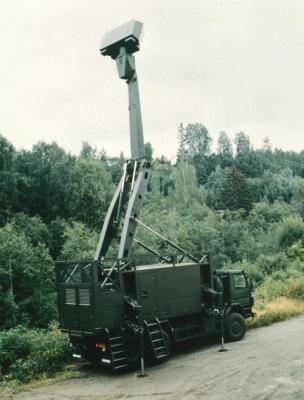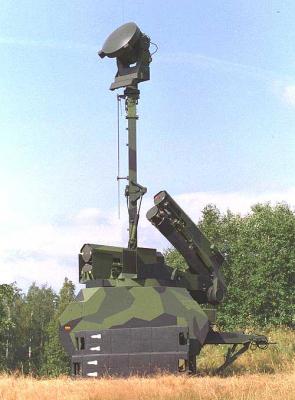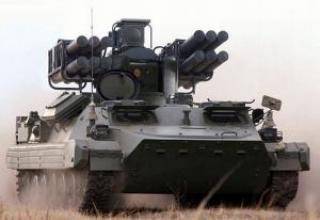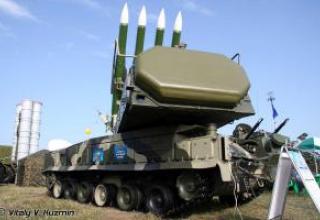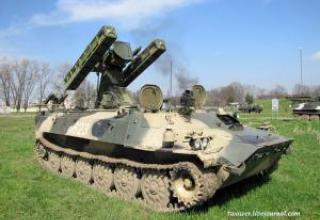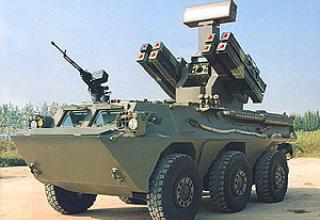The RBS-23 BAMSE anti-aircraft missile system is designed to engage air targets at ranges up to 15 km, at altitudes from several tens to 12,000 meters. The RBS-23 BAMSE air defense system occupies an intermediate position between short- and long-range air defense systems and can be used to cover air bases, seaports and destroy air targets to the point where they can use conventional bomb weapons. The complex is capable of detecting and destroying targets with a low effective scattering surface. Taking into account that the RBS-23 BAMSE SAM system has high mobility and short deployment time, it can be used for air defense of mobile army units.
The development of the complex for the Swedish Armed Forces was started in 1993 under the MSAM (Medium Surface-to-Air Missile System) program, jointly by Bofors Missiles and Ericsson Microwave System AB. The purpose of the program was to create a complex with an intercept area close to the medium-range SAM system, while significantly reducing the total cost of the complex. The missile and guidance cabin of the launcher were developed by Bofors Missiles, the Giraffe AMB-3D observation radar of new generation, the guidance radar and the combat control cabin by Ericsson Microwave System AB.
The first prototype of RBS-23 BAMSE was created in 1998. In case of successful completion of tests and beginning of serial production the complex is planned to be put into service of Swedish Army in 2003.
Experts believe that two or three battalions equipped with the RBS-23 BAMSE complex are enough for Sweden. Next, it is planned to carry out export eaa cises.
Composition:
The RBS-23 BAMSE battery includes a battery control station and two to four towed MCLV (Missile Control and Launch Vehicles) launchers.
The battery control point of the complex is placed on the cross-country vehicle chassis and equipped with a new generation of air target detection radar - "Giraffe AMB - 3D". The combat control cabin of the modular type is located in a standard (ISO) 20-foot container and has built-in protection against electromagnetic radiation, shatterproof armor and a filter-ventilation unit. The control point has its own navigation system and can be equipped with GPS. The deployment time is about 10 minutes. Crew - 1-2 people.
Giraffe AMB - 3D" three-axis monopulse radar with phased antenna array operates in the range of 5.4-5.9 GHz. The original vertical scanning pattern using a wide beam provides a very high rate of information update. The interference immunity of the radar is ensured by the use of an antenna with an ultra-low level of the side blades of the directional pattern, limitation and optimal filtration of echoes, and automatic recording of weather conditions. The radar has an integrated system of operation monitoring and fault location. The instrumental range is 100 km, the maximum height of air targets detection is 20 km. Simultaneous tracking of more than 100 targets is possible. The combat operation process is maximally automated due to the application of a fast digital computing complex (the software is written in the high level language ADA-95), information about the air situation is displayed on two high-resolution raster color monitors. The radar antenna is extended to a height of 12m using a mast device, which allows you to place the battery control point in the shelter, folds, etc. Power supply is provided by an autonomous diesel-electric unit with a capacity of 35KW, which generates 50 Hz AC current (voltage 240/400V).
The control point of the RBS-23 BAMSE complex can also be used to control firepower of other air defense systems.
MCLV launchers can be connected to the battery command post via cable, fiber optic communication line or radio line. The Swedish Army uses TS9000-compliant communication equipment for information exchange, thus achieving the required interference immunity and exchange rate. The battery command post can be up to 10 km away from the launcher.
The towed MCLV launcher has all the necessary means to independently destroy air targets. On the mast device of the chassis, which can be extended to a height of 8 meters, are placed - radar guidance antenna, thermal imaging and identification equipment "in-situ". Each launcher is equipped with a rotating platform with four rechargeable transport and launch containers with missiles. MCLV deployment time is about 10 minutes, recharge time is less than 3 minutes. Missile launch is tilted. The missile is guided in flight by a guidance radar, which is an upgraded version of the "Ericsson Eagle Low Probability of Intercept" (LPI) radar.
The guidance radar operates in the 34-35 GHz range and can point up to two missiles at each target. Its effective range is 30 km. The radar is capable of detecting and tracking targets on the background of the underlying surface (ground), which allows the complex to fire low-altitude targets. The crew of MCLV - two people, is located in the cockpit with shatterproof armor.
It is a two-stage rocket with a command guidance system, high-speed, maximum speed reaches M=3.0. Shrapnel directed combat unit, equipped with contact and non-contact fuses. The missile can destroy all types of air targets - from low-speed targets with a large scattering surface (transport aircraft) to bombs, high-speed cruise and anti-radar missiles.
RBS-23 BAMSE complex has built-in control equipment, training and recording equipment, the last two allow for personal calculation training, fully simulating the conduct of combat operations, excluding real missile launches.
The air transport complex is equipped with C-130 Hercules transport aircraft.
Characteristics:
| Complex RBS-23 BAMSE | |
| Range, km | 15 |
| Maximum height of impact, km | 12 |
| Maximum missile flight speed, M | 3 |
| RADAR "Giraffe AMB - 3D" | |
| Bandwidth, GHz. | 5.4-5.9 (C/G) |
| Instrumental range, km | 100 |
| Maximum target detection altitude, km | 20 кm |
| View sector by location corner, deg | 70 |
| LPI pointing radar | |
| Bandwidth, GHz | 34-35 (Ka) |
| Effective range, km | 30 |
Testing:
As part of the UK's 12th Air Defence Regiment, Rapier SAMs participated in combat operations during the Falkland conflict in 1982. 12 launchers have been deployed since the first day of the English landing on the Falkland Islands. Sources from the English government (White Paper: The Falkland Campaign. Lessons) claim that 14 Argentine planes were destroyed by Rapier complexes. However, according to other information, the "Rapier" complex shot down only one AI Dogger A and participated in the destruction of the A-4C Skyhawk. The Blindfire radar did not participate in these hostilities.
The Rapier complex participated on the Iranian side in the war between Iran and Iraq in the 1970s, and is believed to have destroyed an Iraqi Tu-22 type bomber.
The "Rapier" SAM system was also deployed for the English multinational air defense contingent during Operation Desert Storm in 1991.
Sources:
- НИОКР по созданию зенитного ракетного комплекса RBS 23 BAMSE (Воздушно-космическая оборона)
- RBS 23 BAMSE
- Giraffe AMB
- Василин Н.Я., Гуринович А.Л. "Зенитные ракетные комплексы" .-Мн.: ООО "Попурри", 2002- 464с.
- 3D Search Radar Agile Multi Beam

